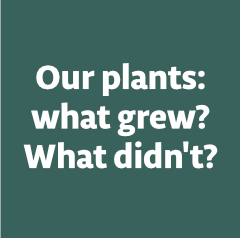Successful plants (in Sacramento)
We update our blog with plant results, maintenance practices, visiting insects and birds and other information. You can see it here.
Our garden is rather special, in that things that do well here may not thrive several blocks away and vice versa. Our bloom season for similar plants seems later, too. So, remembering that each garden's growing conditions are unique, here's our plant list:
Native sages: Hummingbird sage in the foreground, sun or shade. Pozo blue sage in dry areas in full sun. Both attract hummingbirds; the Pozo Blue sage also attracts big black carpenter bees. CN
Hot Lips Sage. A low mounding plant covered with flowers for months. The flowers can be white, magenta or a combination of the two colors, depending on temperature. Needs cutting back in spring, otherwise carefree.
Agaves. Most will die in our cold, wet winters, but some will thrive given good drainage. If you don't want a huge, spiny monster, plant A. parryi. Plant A. vilmorreana for something a bit larger, of if monster is your goal, use A. salmiana.
Santa Barbara Daisy (Erigeron karvinskianus). A trailing daisy that reseeds freely but requires little care. It's not hard to rip out if it's growing where it's not wanted.
Rosemary. We grow upright forms like 'Spice Islands' for cooking. 'Tuscan Blue' is a great bloomer, and the flavor's not bad, either. On mounds.
Siskiyou blue fescue. A nice looking gras that doesn't spread and stays fairly low. Needs to be cut back hard, and may die out in places or look uneven.
Deer Grass (Muhlenbergia rigens). A bold, medium-large grass for a native accent. As long as it's in full sun it should thrive. CN
Karl Foerster Grass (Calamagrostis 'Karl Foerster'). This is a great seasonal vertical accent. Cut it down completely at the end of winter.
Cassa Blue flax lily (Dianella 'Cassablue'). Part shade, sun, little to moderate water. This plant just doesn't seem to mind variable conditions. Its upright spiky blue-gray leaves stay compact and it doesn't spread.
Powis Castle Artemisia. Pinched back, it makes a nice lacy gray ground cover about 18" high. Our native artemisia, A. douglasii is our locally native species - grow it at the back of the garden where it can ramble, since although I like the smell, it's a bit untidy.
Bay Laurel (Laurus nobilis). A tree or shrub, the source of bay leaves. Evergreen, dense and a good screen plant. And we never have to buy bay leaves.
Clustered Field Sedge (Carex praegracilis). Low, neat, evergreen. Happier in part shade with a lot of moisture, it's the main plant in our meadow/rain garden. CN
Annual wildflowers. California poppies, Farewell to Spring, others. These are in a non-irrigated area. They did very well the first year, and the poppies are consistent performers. The Farewll to Spring comes back, but other species have been variable performers. Plant seed in fall before the first rains, do not irrigate outside of the normal rainy season.
Darwin Barberry (Berberis darwinii). Native to Chile and Argentina, with supposedly edible berries, although we haven't tried them yet. Nice yellow-orange flowers in spring, evergreen. Does not transplant, alas.
Creeping Mahonia (Mahonia repens). A low, somewhat prickly subshrub with yellow flowers in spring, if it feels like it. Better in part shade, it does not need a lot of water to be happy. (CN)


